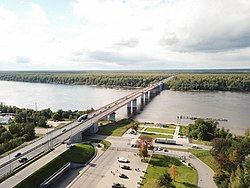
Back Кіраўскі раён (Ленінградская вобласць) Byelorussian Кіраўскі раён (Ленінградзкая вобласьць) BE-X-OLD Кировскан кӀошт (Ленинградан область) CE Kirovskiy Rayon (rayon sa Rusya, Leningradskaya Oblast') CEB Kirovski rajoon Estonian Korotkan piiri Finnish Raïon de Kirovsk (oblast de Léningrad) French Կիրովսկի շրջան Armenian Kirovskij rajon (Oblast' di Leningrado) Italian キロフスク地区 Japanese
Kirovsky District
Кировский район | |
|---|---|
 | |
 Location of Kirovsky District in Leningrad Oblast | |
| Coordinates: 59°52′26″N 31°00′15″E / 59.87389°N 31.00417°E | |
| Country | Russia |
| Federal subject | Leningrad Oblast[1] |
| Established | April 1, 1977[2] |
| Administrative center | Kirovsk[1] |
| Area | |
• Total | 2,590.46 km2 (1,000.18 sq mi) |
| Population | |
• Total | 62,533 |
| • Density | 24/km2 (63/sq mi) |
| • Urban | 82.7% |
| • Rural | 17.3% |
| Administrative structure | |
| • Administrative divisions | 3 Settlement municipal formations (towns), 5 Settlement municipal formations (urban-type settlements), 3 Settlement municipal formations (rural settlements) |
| • Inhabited localities[1] | 3 cities/towns, 5 urban-type settlements[5], 92 rural localities |
| Municipal structure | |
| • Municipally incorporated as | Kirovsky Municipal District[6] |
| • Municipal divisions[6] | 8 urban settlements, 3 rural settlements |
| Time zone | UTC+3 (MSK |
| OKTMO ID | 41625000 |
| Website | http://kirovsk-reg.ru/ |
Kirovsky District (Russian: Ки́ровский райо́н) is an administrative[1] and municipal[6] district (raion), one of the seventeen in Leningrad Oblast, Russia. It is located in the center of the oblast and borders with Volkhovsky District in the east, Kirishsky District in the southeast, Nevsky and Kolpinsky Districts of the federal city of St. Petersburg in the west, Tosnensky District in the southwest, and with Vsevolozhsky District in the northwest. From the north, the district is bounded by Lake Ladoga. The area of the district is 2,590.46 square kilometers (1,000.18 sq mi).[3] Its administrative center is the town of Kirovsk.[1] Population (excluding the administrative center): 62,533 (2010 Census);[4] 60,221 (2002 Census);[8] 74,725 (1989 Soviet census).[9]
- ^ a b c d e Oblast Law #32-oz
- ^ Cite error: The named reference
Histwas invoked but never defined (see the help page). - ^ a b О районе (in Russian). Официальный сайт Кировского муниципального района Ленинградской области. Retrieved June 20, 2013.
- ^ a b Russian Federal State Statistics Service (2011). Всероссийская перепись населения 2010 года. Том 1 [2010 All-Russian Population Census, vol. 1]. Всероссийская перепись населения 2010 года [2010 All-Russia Population Census] (in Russian). Federal State Statistics Service.
- ^ The count of urban-type settlements may include the work settlements, the resort settlements, the suburban (dacha) settlements, as well as urban-type settlements proper.
- ^ a b c Law #100-oz
- ^ "Об исчислении времени". Официальный интернет-портал правовой информации (in Russian). June 3, 2011. Retrieved January 19, 2019.
- ^ Federal State Statistics Service (May 21, 2004). Численность населения России, субъектов Российской Федерации в составе федеральных округов, районов, городских поселений, сельских населённых пунктов – районных центров и сельских населённых пунктов с населением 3 тысячи и более человек [Population of Russia, Its Federal Districts, Federal Subjects, Districts, Urban Localities, Rural Localities—Administrative Centers, and Rural Localities with Population of Over 3,000] (XLS). Всероссийская перепись населения 2002 года [All-Russia Population Census of 2002] (in Russian).
- ^ Всесоюзная перепись населения 1989 г. Численность наличного населения союзных и автономных республик, автономных областей и округов, краёв, областей, районов, городских поселений и сёл-райцентров [All Union Population Census of 1989: Present Population of Union and Autonomous Republics, Autonomous Oblasts and Okrugs, Krais, Oblasts, Districts, Urban Settlements, and Villages Serving as District Administrative Centers]. Всесоюзная перепись населения 1989 года [All-Union Population Census of 1989] (in Russian). Институт демографии Национального исследовательского университета: Высшая школа экономики [Institute of Demography at the National Research University: Higher School of Economics]. 1989 – via Demoscope Weekly.

